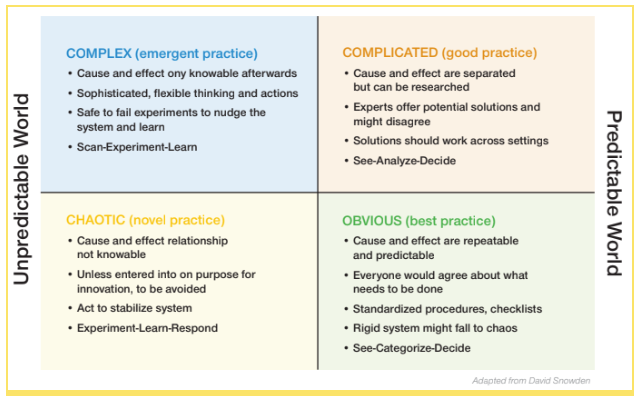People often ask me, “Why is the workplace so complex today?”
And I often hear other references to complexity like “we move so fast,” or “technology is changing so rapidly” or that “we are in the midst of major cultural shifts in our society.”
While those are all true, they are only the symptoms of complexity and not the root cause of it.
In my last post, I stated that I believe the main cause of complexity in our workplace today is unpredictability—the common thread of all of those symptoms.
In an unpredictable world, leaders have to think differently. We can’t continue to use the same process, system, and method of thinking that we’ve used in the past. If we do, we won’t be able to keep up with the rate at which complexity is increasing.
Think about your world. Is your business or organization getting more or less complex? Are the changes you are navigating new or have they been addressed before?
Some, for sure, have been addressed or maybe even solved in the past. But many of the most complex changes we face today haven’t. And that’s precisely where our thinking needs to change.
Cynefin Framework

One framework that can help us understand where our thinking might need to change is the Cynefin Framework developed by David Snowden. Imagine a 4-quadrant grid. On the right side of the framework is the predictable world and on the left is the unpredictable world.
Obvious
In the lower-right corner, on the predictable side, is the obvious quadrant.
This quadrant represents a business, team or organization that is operating in a stable environment. There are typically structures, best practices or even SOPs in place to help guide people. The relationship between cause and effect is clear: if you do X, you can expect Y.
The thinking required by the leader in the obvious quadrant is to observe what is happening, categorize the current situation, and decide on the best course of action based on existing rule structures.
For example, a customer service representative for a well-established product might take a call, look on their support system for canned responses that are the same or similar as the current issue at hand, and provide a response.
Complicated
In the upper-right corner of the framework is the home of the complicated.
In this quadrant, there is more complexity, but the relationship between cause and effect can still be determined. The answer exists, but often takes the input of an expert. There usually isn’t just one solution, but a range of answers.
This is the arena of data scientists, attorneys, doctors and other experts. Artificial intelligence and machine learning work well in this arena as they can quickly assess a problem, scan for possible solutions, and move forward.
The thinking required by the leader in the complicated quadrant is to observe their environment, analyze the options using their or others’ expertise, and decide on a course of action.
Complex
Moving to the upper-left corner takes us into the territory of the unpredictable world where you’ll find the complex quadrant.
This is the arena where much of the change and disruption we face in our workplace today lies, such as how we navigate an acquisition or divestiture or address the threat of a growing competitor. It is an arena in which the cause and effect are not obvious and can only be deduced after the fact. Adding to the complexity is the fact that there might not be just one right answer.
In the complex arena, leaders can understand why things happen only in retrospect. According to the Cynefin model, instructive patterns can emerge if the leader conducts experiments that are safe to fail. This is precisely where the same thinking that worked for a leader in a predictable world doesn’t work in an unpredictable world.
Leaders have to scan the environment, experiment,and then learn — patiently allowing patterns to emerge.
Chaos
And the final quadrant, in the lower-left corner (also on the unpredictable side of the Cynefin Framework), is the land of the chaotic.
In the chaotic arena, a leader’s immediate job is not to discover patterns, but to stop the bleeding.
Situations that fall into this quadrant might include accidents in manufacturing facilities, emergency crises like a terrorist attack or natural disaster, or even combat.
Leaders need to bring stability by first acting quickly, learning, and responding to transform the situation from chaos to complexity, where identifying patterns can both help prevent future crises and discern new opportunities. Communication is typically direct and top down, simply because there is no time to ask for input from others.
The risk here is that this isn’t a sustainable style of leadership and comes with liabilities for the leader, people, and the business when the organization is not in crisis.
Radically Shift Your Thinking Toolkit
I hope the Cynefin Framework is helpful to see where a leader’s thinking might need to change in our unpredictable world. Stay tuned for more on the future of leadership in upcoming posts.
If you haven’t seen these already, we have two tools that can help you radically shift your thinking as you are making day-to-day business decisions. The first is a one-page infographic to help you consider your current situation, the assumptions and beliefs that may be driving your decision making, and new questions to challenge your point of view. The second is a recording of my Future of Leadership masterclass.

